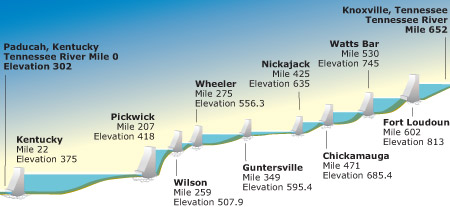How the System Works
Dams and locks
TVA is required by the TVA Act to maintain a nine-foot channel on the Tennessee River so commercial vessels can move their goods by water efficiently year round.
Nine main and four auxiliary locks on the Tennessee River make it possible for both commercial and recreational vessels to pass easily from one reservoir to another. Much like an elevator, these locks raise or lower barges and other boats from one water level to the next.
Movie of barge moving through locks
When a boat enters the lock, the gates close and the water level inside the lock is raised to the upstream level or lowered to the downstream level, depending on which way the boat is moving. The locks are filled and emptied by gravity — no pumps are used.
If the boat is going downstream, the water level in the lock is lowered by opening the downstream valves so the water can drain out. If the boat is moving upstream, the downstream valves are closed and the upstream valves are opened. This allows water from the upstream side to flow into the lock, filling the chamber to the upstream water level. In about 45 minutes, when the water level inside the lock is equal to the level of the next reservoir, gates at the other end of the lock are opened and the boat can continue on its way.
The largest lock, at Pickwick Dam, is 110 feet wide and 1,000 feet long. The lock at Kentucky Dam is the busiest on the entire system, handling about 35 million tons of river freight per year. The locks at Nickajack, Guntersville, Wheeler and Kentucky dams operate 24 hours a day, 365 days a year. Call for information about hours of operation at Chickamauga, Fort Loudoun, Melton Hill, and Watts Bar dams. All locks on the Tennessee River are available for use without charge.
Tennessee River System
 |
Nine main-river dams form a “staircase” of quiet, pooled water and controlled current — a continuous series of reservoirs that stretches along the entire length of the Tennessee River. From its beginning just above Knoxville, the Tennessee drops a total of 513 feet in elevation before it joins the Ohio River. |
River responsibilities
TVA, the U.S. Army Corps of Engineers, and the U.S. Coast Guard work together to provide a safe and reliable passage for commercial and recreational vessels on the Tennessee River.
The Tennessee River system is managed through a series of dams and navigation locks owned by the United States and operated by TVA and the U.S. Army Corps of Engineers. In accordance with the TVA Act, TVA is entrusted with the possession, operation and control of the dams and all related buildings, machinery, and lands, with the exception of the navigation locks which are operated by the U.S. Army Corps of Engineers.
The Coast Guard has specific regulatory responsibilities for enforcing maritime laws, ensuring commercial marine safety, and investigating marine accidents. In addition, the Coast Guard installs and maintains the navigation aids — buoys, lights, and shoreline markers — along roughly 800 miles of commercial channel. TVA installs and maintains the navigational aids on about 375 miles of secondary, or recreational, channels across the Tennessee Valley.
Tennessee River Waterway Management Plan
The Tennessee River Waterway Management Plan was developed to facilitate the safe and orderly movement of barge traffic during navigational emergencies on the Tennessee River system. It was jointly prepared by the marine industry, U. S. Coast Guard, U. S. Army Corps of Engineers, and TVA.
The goal of the plan is to serve as a guide for officials of these agencies, local emergency management agencies, and the marine industry during periods of less-than-optimum conditions such as natural and/or man-made disasters, high or low water events, and other incidents such as spills, lock closures, and bridge construction or demolition. It provides background information on the hydrological and meteorological factors that affect the Tennessee River system, as well as communication guidelines, points of contact, and criteria associated with each phase of emergency response.
Tennessee River Waterway Management Plan (PDF, 744 kb)
E-mail khhammond@tva.gov for a current list of Assigned Dedicated Contact Persons.